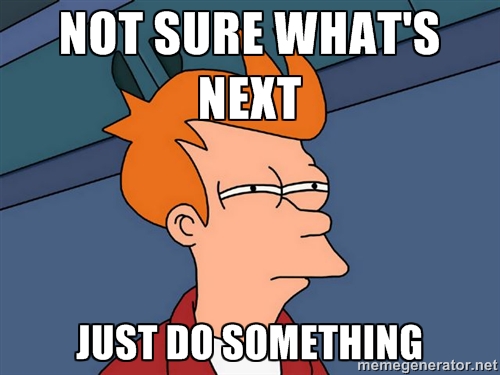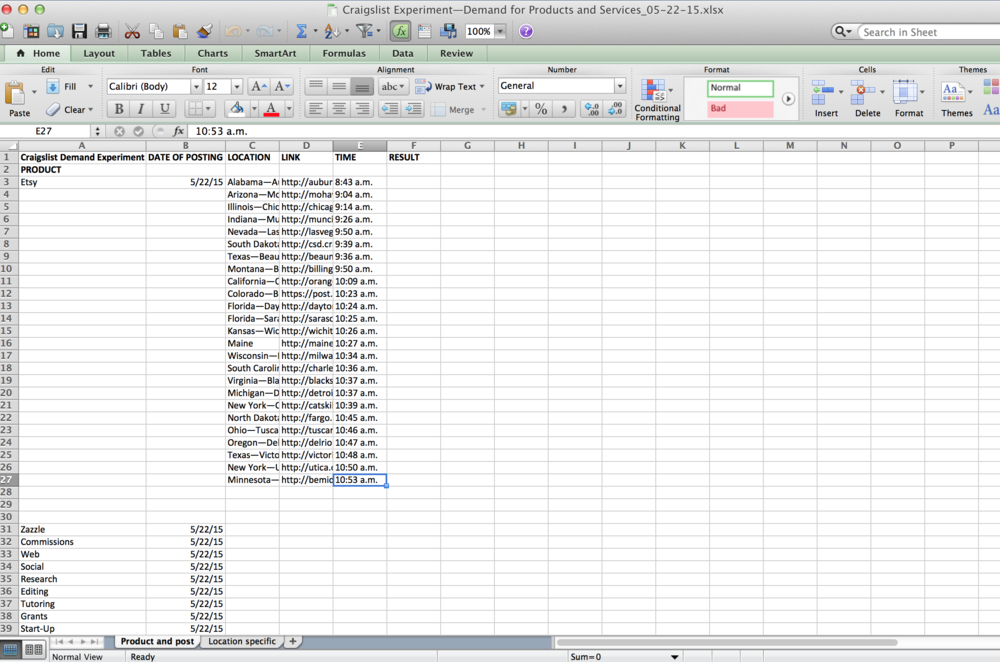After a few hours spent posting a mere 25 Craigslist ads, the Internet and I reached a consensus that this was probably a stupid way of testing for demand for the products and services I can think to offer.

To recap, I recognized my failure to monetize a business in a few months as… A failure to monetize a business in a few months. Typical but suboptimal. Thought about why that happened. Decided I needed to figure out what I could offer that would sell like my car. And made this list of 14 things that might be like that thing if I pitched them to the market.
Then I started moving like a researcher.
It’s always a mistake to move like a researcher when you can move like Christopher Walken.
My new business friends who are good at framing things like to say they’re not mistakes. They’re free seminars. So here’s a free seminar I made this morning.
Morning Seminar: Go Where the Water Is

My first mistake was approximating equalization. This is wonky social science terminology for not randomizing groups to treatment and control like in a true experiment, but just planning on doing something like every other. Or in this case, posting each of the 14 possible goods/services I brainstormed to one Craigslist market every 14 cities on the global list of Craigslist markets.
That’s how I wound up posting about my oil paintings to Bemidji, Minnesota. Which was about when I decided this was dumb.
That was also about when my posting speed improved. So it started driving me less crazy to do this dumb, repetitive task! But Craigslist also picked up on my improvement and said—whoa there, you can’t post that fast.
Don’t they know they’re providing me free market research services?
The positive way of saying this is: not all market research is created equal. I don’t care about how the effects of my ads scale to tiny markets. I only care about big ones. So I should have started by crossing off the Bemidjis or just circling the Detroits. You go where the water is in all areas of life. And in market research terms, that means testing in larger populations, especially where you’re more likely to find people like you.
I can vastly improve on the first idea of how to do a little market research—approximately equalize 14 Craigslist ads across global Craigslist service areas to see who responds to what—by going where the water is. That means:
1. Target demographic centers. More people (within the Western context) = more business. So I want to post to Detroit, not Bemidji.
2. Tailor tests. More artsy types = more art business. More colleges = more editing and tutoring work. Etc. So maybe I wanted to post about my paintings to Santa Fe, not Daytona Beach.
3. Grouping products and services. My list from earlier this morning of 14 products or services really condenses to six groups of products or services. Reframing things within categories ensures that a potential client who’s interested in one thing (like paintings on Etsy) gets the chance to express potential interest in a closely related other thing (like art merchandise on Zazzle).
The old list looked like this after I coded it for easier “approximation of equalization” and Excel stuff:
Products and Services to Test Demand for on Craigslists A
1. The paintings I’m selling on Etsy ? Etsy (E)
2. The art merchandise I’m selling on Zazzle ? Zazzle (Z)
3. Painting commissions ? Commissions (C)
4. Website and online store design and building—I made my own ? Web (W)
5. Social media management—making a business social media presence across platforms, and teaching the fundamentals of how to engage the right networks and maintain them yourself ? Social (S)
6. Market research—what I’m doing right now with Craigslist, and more in-depth experimentation in other ways using other tools ? Research (R)
7. Editing and submissions advice ? Editing (E2)
8. Tutoring ? Tutoring (T)
9. Grant proposal assistance ? Grants (G)
10. Start-up consulting/Entrepreneurship coaching ? Start-up (S2)
11. Positive selective attention coaching ? Positivity (P)
12. Low information diet coaching ? Low-info (L)
13. Books, my precious books ? Books (B)
14. World peace through art ? Peace (P)
The new list looks more like this:
Products and Services to Test Demand for on Craigslists B
1. Art: paintings on Etsy, merch on Zazzle, commissions on website.
2. Editing, tutoring, grant proposal assistance (for which I already have a website up and running).
3. Web support for business: website and online store design and building + social media management.
4. Market research and start-up consulting.
5. Positive selective attention & low-information diet coaching. (Both of these things are about cognitive and emotional resource management, but that’s not the best possible language to pitch them with.)
6. What are actually my pet projects I’m not sure I can monetize on an immediate timetable if at all, but doing what I want is the point of all of this, so I might as well try—my books and my world peace through art plot.
New Plan
As much as I hate to spend a few more hours on Craigslist not knowing if this way of testing for demand for services will work at all, it seems important to at least follow through on the revised experiment. That means whipping up ads for 2-6 in the updated product and services list, matching each category to appropriate areas by common sense or intuition, and giving it a go.
This will get tricky when I get to #6, which is probably where I should have started since it’s the most important set of possibilities to me. But it will also take the longest to work through.
Market research for unwritten books is tricky. Commercially successful authors of recent note like J.K. Rowling have established fan bases online through fora and other community-building. I don’t have anything that fancy set up. So I probably want to create a survey summarizing ten possible book projects and ask my blog readers, Facebook friends, and Twitter followers to help me by voting or saying what they want. The trouble with that is that it doesn’t involve money, and we know that attitudes (I like/don’t like this) and behaviors (I will actually give you money or not for this) can diverge quite a bit.
And I don’t know about posting my world peace through art proposal. It’s beautiful in my head and might sound stupid outside of it. Plus, if it’s a good idea, maybe I should just pull it off anonymously. That’s often how I work best. Plus, the SCORE (retired executive) members I got free Small Business Administration advising from thought I should be pitching a bolder, crazier plan to the Internets—but I’m pretty sure this one is actually too crazy to put out there unless I pull it off first and then talk about it later, if it works. That’s how I did college apps (two years early without a high school diploma), my name change (no one in my family knew for over a year when I legally changed every part of my name), and relationships in my 20s.
This social network stuff is hard, new, and weird. But you can see—at the long end of the statistical tail of success stories—how when it works, it really works. And in the middle of the distribution, people have better health, emotional, and financial outcomes when they have strong social support networks. You don’t build them by quietly trudging along or gunning for something other than your dreams. Although I’m not sure how you do build them. Or indeed how you know your dreams without just trying a bunch of stuff to see what feels right and what works. But I’m also not sure how you get success on any meaningful terms without pouring all the crazy out of your heart and onto the fire. Someday maybe that will be a seminar. For now it’s a plan.